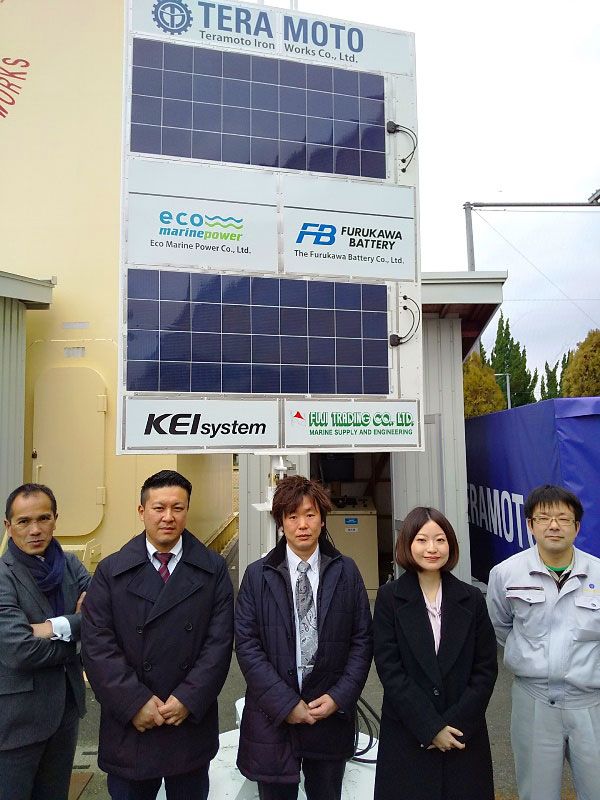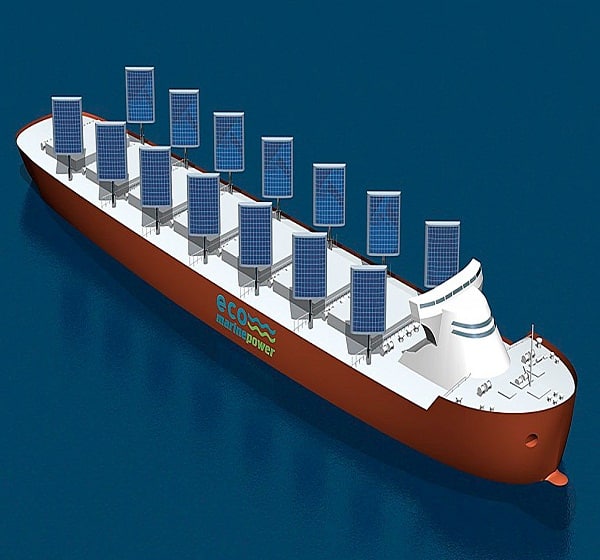The global shipping industry is experiencing a wind-powered revival. Metal cylinders now spin from the decks of a half-dozen cargo ships, easing the burden on diesel engines and curbing fuel consumption. Devices like giant towing kites, vertical suction wings, and telescoping masts are well underway, while canvas sails flutter once more on smaller vessels.
The latest development in “wind-assisted propulsion” comes from Japan. Eco Marine Power (EMP) recently unveiled a full-scale version of its EnergySail system at the Onomichi Marine Tech Test Center in Hiroshima Prefecture. The rigid, rectangular device is slightly curved and can be positioned into the wind to create lift, helping propel vessels forward. Marine-grade solar panels along the face can supply electricity for onboard lighting and equipment.
Greg Atkinson, EMP’s chief technology officer, says the 4-meter-tall sail will undergo shore-based testing this year, in preparation for sea trials. The device will deliver 1-kilowatt in peak solar power, or kWp, though the startup is still evaluating which type of photovoltaic panel to use. The potential sail power is yet to be determined, he says.
The EnergySail is one piece of EMP’s larger technology platform. The Fukuoka-based firm is also developing an integrated system that includes deck-mounted solar panels; recyclable marine batteries; charging systems; and computer programs that automatically rotate sails to capture optimal amounts of wind, or lower the devices when not in use or during bad weather. Atkinson notes that moving an EnergySail (mainly to optimize its wind collection) may affect how much sunlight it receives, though the panels can still collect solar power when lying flat.
The startup’s ultimate goal is to hoist about a dozen EnergySails on a tanker or freighter that has the available deck space. An array of that size could deliver power savings of up to 15 percent, depending on wind conditions and the vessel’s size, models show.
Gavin Allwright, secretary of the International Windship Association, says that figure is in line with projections for other wind-assisted technologies, which can help watercraft achieve between 5 and 20 percent fuel savings compared to typical ships. (EMP is not a member of the association.) For instance, the Finnish company Norsepower recently outfitted a Maersk oil tanker with two spinning rotor sails. The devices lowered the vessel’s fuel use by 8.2 percent on average during a 12-month trial period.
Shipping companies are increasingly investing in clean energy as international regulators move to slash global greenhouse gas emissions. Nearly all commercial cargo ships use oil or gas to carry goods across the globe; together, they contribute up to 3 percent of the world’s total annual fossil fuel emissions. Zero-emission alternatives like hydrogen fuel cells and ammonia-burning engines are still years from commercialization. But wind-assisted propulsion represents a more immediate, if partial, solution.
For its EnergySail unit, EMP partnered with Teramoto Iron Works, which built the first rigid sails in the 1980s. Those devices — called JAMDA sails after the Japan Marine Machinery Development Association—were shown to reduce ships’ fuel use by between 10 to 30 percent on smaller coastal vessels, despite some technical issues. However, the experiment was short-lived. Plunging oil prices eroded the business case for efficiency upgrades, and shipowners later took them down.
EMP is currently talking with several shipowners to start installing its full energy system, potentially later this year. For the sea trial, the startup plans to install a deck-mounted solar array with up to 25 kWp; battery packs; computer systems; and one or two EnergySails. Atkinson says it may take two to three years of testing to verify whether the equipment can weather harsh conditions, including fierce winds and corrosive saltwater.

Photo: Eco Marine Power Eco Marine Power partners pose in front of the EnergySail demonstration and test unit at the Onomichi Marine Tech Test Center in Hiroshima Prefecture, Japan, in February 2020.
Separately, EMP has started testing the non-sail portion of its platform. In May 2019, the company installed a 1.2-kWp solar array on a large crane vessel owned by Singaporean carrier Masterbulk. The setup also includes a 3.6-kilowatt-hour VRLA (valve regulated lead acid) battery pack made by Furukawa Battery Co. An onboard monitoring system automatically reports and logs fuel-consumption data in real time and calculates daily emissions of carbon and sulfur dioxide.
EMP previously tested Furukawa’s batteries on a vessel in Greece. During the day, solar panels recharged the batteries, which keep the voltage stable and could directly power the vessel’s lighting load. The batteries could also store the excess solar power to keep the lights on at night. It took the partners about five years of testing to ensure the system was stable.
Atkinson says that, so far, the COVID-19 pandemic hasn’t disrupted the company’s work or halted its plans for the year.
“We can do much of the design work remotely and by using cloud-based applications,” he says. “Also, we can use virtual wind tunnels and [Computer Aided Design] applications for much of the initial design work for the sea trials phase.”
Across the industry, however, the coronavirus outbreak is wreaking economic havoc. Allwright says that shipowner interest in wind-assisted propulsion was “absolutely crazy” until a few weeks ago. “Now, shipping companies are saying, ‘Look, we can’t invest in new technology right now because we’re trying to survive,’” he says.
Still, some technology developers are nonetheless accelerating their design work, in the hopes of launching projects as soon as the industry bounces back. “This pause gives the providers an extra 12 months to get these things tested and ready for action,” Allwright says.
Source: Spectrum










